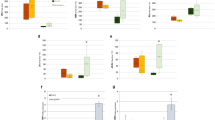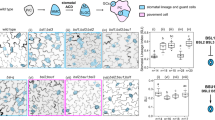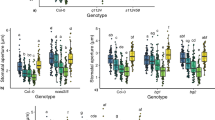Abstract
Plants must coordinate the regulation of biochemistry and anatomy to optimize photosynthesis and water-use efficiency. The formation of stomata, epidermal pores that facilitate gas exchange, is highly coordinated with other aspects of photosynthetic development. The signalling pathways controlling stomata development are not fully understood1,2, although mitogen-activated protein kinase (MAPK) signalling is known to have key roles. Here we demonstrate in Arabidopsis that brassinosteroid regulates stomatal development by activating the MAPK kinase kinase (MAPKKK) YDA (also known as YODA). Genetic analyses indicate that receptor kinase-mediated brassinosteroid signalling inhibits stomatal development through the glycogen synthase kinase 3 (GSK3)-like kinase BIN2, and BIN2 acts upstream of YDA but downstream of the ERECTA family of receptor kinases. Complementary in vitro and in vivo assays show that BIN2 phosphorylates YDA to inhibit YDA phosphorylation of its substrate MKK4, and that activities of downstream MAPKs are reduced in brassinosteroid-deficient mutants but increased by treatment with either brassinosteroid or GSK3-kinase inhibitor. Our results indicate that brassinosteroid inhibits stomatal development by alleviating GSK3-mediated inhibition of this MAPK module, providing two key links; that of a plant MAPKKK to its upstream regulators and of brassinosteroid to a specific developmental output.
This is a preview of subscription content, access via your institution
Access options
Subscribe to this journal
Receive 51 print issues and online access
$199.00 per year
only $3.90 per issue
Buy this article
- Purchase on Springer Link
- Instant access to full article PDF
Prices may be subject to local taxes which are calculated during checkout



Similar content being viewed by others
Change history
08 February 2012
The original supplementary information file posted online was incorrect and has been replaced.
References
Bergmann, D. C. & Sack, F. D. Stomatal development. Annu. Rev. Plant Biol. 58, 163–181 (2007)
Dong, J. & Bergmann, D. C. Stomatal patterning and development. Curr. Top. Dev. Biol. 91, 267–297 (2010)
Thummel, C. S. & Chory, J. Steroid signaling in plants and insects—common themes, different pathways. Genes Dev. 16, 3113–3129 (2002)
Kim, T. W. & Wang, Z. Y. Brassinosteroid signal transduction from receptor kinases to transcription factors. Annu. Rev. Plant Biol. 61, 681–704 (2010)
Kinoshita, T. et al. Binding of brassinosteroids to the extracellular domain of plant receptor kinase BRI1. Nature 433, 167–171 (2005)
Hothorn, M. et al. Structural basis of steroid hormone perception by the receptor kinase BRI1. Nature 474, 467–471 (2011)
She, J. et al. Structural insight into brassinosteroid perception by BRI1. Nature 474, 472–476 (2011)
Tang, W. et al. BSKs mediate signal transduction from the receptor kinase BRI1 in Arabidopsis. Science 321, 557–560 (2008)
Kim, T.-W. et al. Brassinosteroid signal transduction from cell-surface receptor kinases to nuclear transcription factors. Nature Cell Biol. 11, 1254–1260 (2009)
Tang, W. et al. PP2A activates brassinosteroid-responsive gene expression and plant growth by dephosphorylating BZR1. Nature Cell Biol. 13, 124–131 (2011)
Li, J. & Nam, K. H. Regulation of brassinosteroid signaling by a GSK3/SHAGGY-like kinase. Science 295, 1299–1301 (2002)
He, J. X., Gendron, J. M., Yang, Y., Li, J. & Wang, Z. Y. The GSK3-like kinase BIN2 phosphorylates and destabilizes BZR1, a positive regulator of the brassinosteroid signaling pathway in Arabidopsis. Proc. Natl Acad. Sci. USA 99, 10185–10190 (2002)
Saibo, N. J., Vriezen, W. H., Beemster, G. T. & Van Der Straeten, D. Growth and stomata development of Arabidopsis hypocotyls are controlled by gibberellins and modulated by ethylene and auxins. Plant J. 33, 989–1000 (2003)
Kang, C. Y., Lian, H. L., Wang, F. F., Huang, J. R. & Yang, H. Q. Cryptochromes, phytochromes, and COP1 regulate light-controlled stomatal development in Arabidopsis. Plant Cell 21, 2624–2641 (2009)
Wang, H., Ngwenyama, N., Liu, Y., Walker, J. C. & Zhang, S. Stomatal development and patterning are regulated by environmentally responsive mitogen-activated protein kinases in Arabidopsis. Plant Cell 19, 63–73 (2007)
Lampard, G. R., Macalister, C. A. & Bergmann, D. C. Arabidopsis stomatal initiation is controlled by MAPK-mediated regulation of the bHLH SPEECHLESS. Science 322, 1113–1116 (2008)
Rowe, M. H. & Bergmann, D. C. Complex signals for simple cells: the expanding ranks of signals and receptors guiding stomatal development. Curr. Opin. Plant Biol. 13, 548–555 (2010)
Szekeres, M. et al. Brassinosteroids rescue the deficiency of CYP90, a cytochrome P450, controlling cell elongation and de-etiolation in Arabidopsis. Cell 85, 171–182 (1996)
Wang, Z. Y. et al. Nuclear-localized BZR1 mediates brassinosteroid-induced growth and feedback suppression of brassinosteroid biosynthesis. Dev. Cell 2, 505–513 (2002)
De Rybel, B. et al. Chemical inhibition of a subset of Arabidopsis thaliana GSK3-like kinases activates brassinosteroid signaling. Chem. Biol. 16, 594–604 (2009)
Rozhon, W., Mayerhofer, J., Petutschnig, E., Fujioka, S. & Jonak, C. ASKθ, a group-III Arabidopsis GSK3, functions in the brassinosteroid signalling pathway. Plant J. 62, 215–223 (2010)
Bergmann, D. C., Lukowitz, W. & Somerville, C. R. Stomatal development and pattern controlled by a MAPKK kinase. Science 304, 1494–1497 (2004)
Zhang, J. et al. A Pseudomonas syringae effector inactivates MAPKs to suppress PAMP-induced immunity in plants. Cell Host Microbe 1, 175–185 (2007)
Kanaoka, M. M. et al. SCREAM/ICE1 and SCREAM2 specify three cell-state transitional steps leading to Arabidopsis stomatal differentiation. Plant Cell 20, 1775–1785 (2008)
Li, J., Nagpal, P., Vitart, V., McMorris, T. C. & Chory, J. A role for brassinosteroids in light-dependent development of Arabidopsis. Science 272, 398–401 (1996)
Sun, Y. et al. Integration of brassinosteroid signal transduction with the transcription network for plant growth regulation in Arabidopsis. Dev. Cell 19, 765–777 (2010)
Luo, X.-M. et al. Integration of light and brassinosteroid signaling pathways by a GATA transcription factor in Arabidopsis. Dev. Cell 19, 872–883 (2010)
Chinchilla, D. et al. A flagellin-induced complex of the receptor FLS2 and BAK1 initiates plant defence. Nature 448, 497–500 (2007)
Wrzaczek, M., Rozhon, W. & Jonak, C. A proteasome-regulated glycogen synthase kinase-3 modulates disease response in plants. J. Biol. Chem. 282, 5249–5255 (2007)
Zhang, S. & Klessig, D. F. Salicylic acid activates a 48-kD MAP kinase in tobacco. Plant Cell 9, 809–824 (1997)
Yan, Z., Zhao, J., Peng, P., Chihara, R. K. & Li, J. BIN2 functions redundantly with other Arabidopsis GSK3-like kinases to regulate brassinosteroid signaling. Plant Physiol. 150, 710–721 (2009)
Shpak, E. D., McAbee, J. M., Pillitteri, L. J. & Torii, K. U. Stomatal patterning and differentiation by synergistic interactions of receptor kinases. Science 309, 290–293 (2005)
Earley, K. W. et al. Gateway-compatible vectors for plant functional genomics and proteomics. Plant J. 45, 616–629 (2006)
Acknowledgements
We thank K. Torii for providing seeds of the er erl1 erl2 triple mutant and scrm-D mutant, J.-M. Zhou for providing the HOPAI1 transgenic line and J. Li for providing the bin2-3 bil1 bil2 triple mutant. Research was primarily supported by a grant from the National Institutes of Health (R01GM066258), and partially supported by the US Department of Energy (DE-FG02-08ER15973) and the Herman Frasch Foundation. D.C.B. is an investigator of the Howard Hughes Medical Institute.
Author information
Authors and Affiliations
Contributions
T.-W.K. performed all experiments. T.-W.K. and Z.-Y.W. designed the experiments, analysed data and wrote the manuscript. M.M. cloned complementary DNAs of BSL2 and BSL3, and BSL2pro-BSL2. D.C.B. contributed materials and wrote the manuscript.
Corresponding author
Ethics declarations
Competing interests
The authors declare no competing financial interests.
Supplementary information
Supplementary Information
This file contains Supplementary Figures 1-13 with legends. The original file posted online was incorrect and was replaced on 8 February 2012. (PDF 4371 kb)
Rights and permissions
About this article
Cite this article
Kim, TW., Michniewicz, M., Bergmann, D. et al. Brassinosteroid regulates stomatal development by GSK3-mediated inhibition of a MAPK pathway. Nature 482, 419–422 (2012). https://doi.org/10.1038/nature10794
Received:
Accepted:
Published:
Issue Date:
DOI: https://doi.org/10.1038/nature10794
This article is cited by
-
Exogenously Applied 24-Epibrassinolide Favours Stomatal Performance, ROS Detoxification and Nutritional Balance, Alleviating Oxidative Damage Against the Photosynthetic Apparatus in Tomato Leaves Under Nickel Stress
Journal of Plant Growth Regulation (2023)
-
24-Epibrasinolide Delays Chlorophyll Degradation and Stimulates the Photosynthetic Machinery in Magnesium-Stressed Soybean Plants
Journal of Plant Growth Regulation (2023)
-
RNA-seq profiling in leaf tissues of two soybean (Glycine max [L.] Merr.) cultivars that show contrasting responses to drought stress during early developmental stages
Molecular Breeding (2023)
-
OrMKK3 Influences Morphology and Grain Size in Rice
Journal of Plant Biology (2023)
-
Dichotomy of the BSL phosphatase signaling spatially regulates MAPK components in stomatal fate determination
Nature Communications (2022)
Comments
By submitting a comment you agree to abide by our Terms and Community Guidelines. If you find something abusive or that does not comply with our terms or guidelines please flag it as inappropriate.



